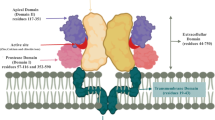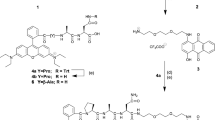Abstract
Proteases are a class of enzymes that lower the activation energy for the cleavage of the peptide bonds by polarizing the carbonyl group. The catalytic mechanism of proteases is characterized by the formation and the dissociation of a tetrahedral acyl-intermediate. The rate-limiting step in catalysis is either the acylation process (leading to the release of the newly formed \( {-}{\text{NH}}_{3}^{ + } \) terminal) or the subsequent deacylation step (leading to the release of the newly formed –COO− terminal). As a case, the detailed kinetic analysis for the hydrolysis of the chromogenic substrate Mu-His-Ser-Ser-Lys-Leu-Gln-AMC (wherein Mu is the morpholinocarbonyl protecting group and AMC is the 7-amino-4-methylcoumarin chromophoric group) by the prostate-specific antigen (PSA) is reported here. The pH dependence of the catalytic parameters clearly indicates the existence of protonation/deprotonation processes involving (at least) two ionizing groups in the proximity of the active site. In view of the physio-pathological relevance of PSA in prostate diseases (including cancer), the detailed analysis of the catalytic parameters opens new scenarios for the design of selective inhibitors, which might influence the “in vivo” activity of this protease.








Similar content being viewed by others
Abbreviations
- PSA:
-
Prostate-specific antigen
References
Antonini E, Ascenzi P (1981) The mechanism of trypsin catalysis at low pH. Proposal for a structural model. J Biol Chem 256:12449–12455
Ascenzi P, Menegatti E, Guarneri M, Bortolotti F, Antonini E (1982) Catalytic properties of serine proteases. 2. Comparison between human urinary kallikrein and human urokinase, bovine β-trypsin, bovine thrombin, and bovine α-chymotrypsin. Biochemistry 21:2483–2490
Ascenzi P, Amiconi G, Bolognesi M, Guarneri M, Menegatti E, Antonini E (1984) The pH dependence of pre-steady-state and steady-state kinetics for the porcine pancreatic β-kallikrein-B-catalyzed hydrolysis of N-α-carbobenzoxy-l-arginine p-nitrophenyl ester. Biochim Biophys Acta 785:75–80
Ascenzi P, Menegatti E, Bolognesi M, Guarneri M, Amiconi G (1986) Catalytic properties of bovine α-thrombin: a comparative steady-state and pre-steady-state study. Biochim Biophys Acta 871:319–323
Ascenzi P, Menegatti E, Guarneri M, Amiconi G (1989) Trypsin-like serine proteinase action: determination of the catalytic parameters K S, k +2 and k +3 under conditions where the substrate exceeds the enzyme concentration. Biochim Biophys Acta 998:210–214
Aureli L, Gioia M, Cerbara I, Monaco S, Fasciglione GF, Marini S, Ascenzi P, Topai A, Coletta M (2008) Structural bases for substrate and inhibitor recognition by matrix metalloproteinases. Curr Med Chem 15:2192–2222
Avgeris M, Scorilas A (2016) Kallikrein-related peptidases (KLKs) as emerging therapeutic targets: focus on prostate cancer and skin pathologies. Expert Opin Ther Targets 20:801–818
Cereda V, Formica V, Menghi A, Pellicori S, Roselli M (2015) Kallikrein-related peptidases targeted terapies in prostate cancer: perspectives and challenges. Expert Opin Investig Drugs 24:929–947
Denmeade SR, Lou W, Lövgren J, Malm J, Lilja H, Isaacs JT (1997) Specific and efficient peptide substrates for assaying the proteolytic activity of prostate-specific antigen. Cancer Res 57:4924–4930
Denmeade SR, Sokoll LJ, Chan DW, Khan SR, Isaacs JT (2001) Concentration of enzymatically active prostate-specific antigen (PSA) in the extracellular fluid of primary human prostate cancers and human prostate cancer xenograft models. Prostate 48:1–6
Gioia M, Fasciglione GF, Monaco S, Iundusi R, Sbardella D, Marini S, Tarantino U, Coletta M (2010) pH dependence of the enzymatic processing of collagen I by MMP-1 (fibroblast collagenase), MMP-2 (gelatinase A) and MMP-14 ectodomain. J Biol Inorg Chem 15:1219–1232
Ilic D, Neuberger MM, Djulbegovic M, Dahm P (2013) Screening for prostate cancer: an updated Cochrane systematic review. BJU Int 107:882–891
LeBeau AM, Singh P, Isaacs JT, Denmeade SR (2009) Prostate-specific antigen is a “chymotrypsin-like” serine protease with unique P1 substrate specificity. Biochemistry 48:3490–3496
Lilja H (1985) A kallikrein-like serine protease in prostatic fluid cleaves the predominant seminal vesicle protein. J Clin Investig 76:1899–1903
Mancek-Keber M (2014) Inflammation-mediating proteases: structure, function in (patho) physiology and inhibition. Protein Pept Lett 21:1209–1229
Menez R, Michel S, Muller BH, Bossus M, Ducancel F, Jolivet-Reynaud C, Stura EA (2008) Crystal structure of a ternary complex between human prostate-specific antigen, its substrate acyl intermediate and an activating antibody. J Mol Biol 376:1021–1033
Singh P, LeBeau AM, Lilja H, Denmeade SR, Isaacs JT (2009) Molecular insights into substrate specificity of prostate specific antigen through structural modeling. Proteins 77:984–993
Sotiropoulou G, Pampalakis G, Diamandis EP (2009) Functional roles of human kallikrein-related peptidases. J Biol Chem 284:32989–32994
Tomao L, Sbardella D, Gioia M, Marini S, Ascenzi P, Coletta M (2014) Characterization of the prostate-specific antigem (PSA) catalytic mechanism: a pre-steady-state and steady-state study. PLoS ONE 7:e102470
Watt KW, Lee PJ, M’Timkulu T, Chan WP, Loor R (1986) Human prostate-specific antigen: structural and functional similarity with serine proteases. Proc Natl Acad Sci USA 83:3166–3170
Webber MM, Waghray A, Bello D (1995) Prostate-specific antigen, a serine protease, facilitates human prostate cancer cell invasion. Clin Cancer Res 1:1089–1094
Williams SA, Singh P, Isaacs JT, Denmeade SR (2007) Does PSA play a role as a promoting agent during the initiation and/or progression of prostate cancer? Prostate 67:312–329
Acknowledgements
This work was financially supported by the Italian Ministry of University and Research (MIUR 265 PRIN 200993WWF_003 to M.C. and CLA 2014 to P.A).
Author information
Authors and Affiliations
Corresponding author
Rights and permissions
About this article
Cite this article
Gioia, M., Tomao, L., Sbardella, D. et al. Enzyme catalysis: the case of the prostate-specific antigen. Rend. Fis. Acc. Lincei 28 (Suppl 1), 229–237 (2017). https://doi.org/10.1007/s12210-017-0602-6
Received:
Accepted:
Published:
Issue Date:
DOI: https://doi.org/10.1007/s12210-017-0602-6




